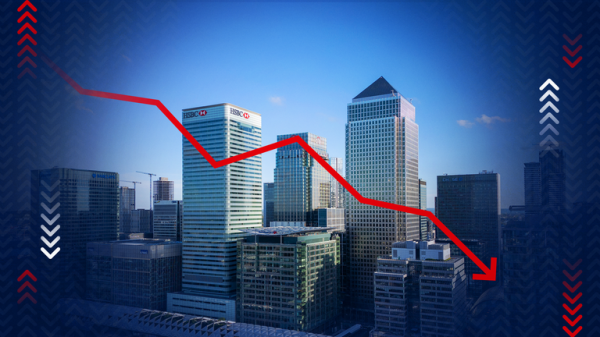
The first interest rate cut since the start of the COVID pandemic is good news – but experts are warning of a hard slog back towards more comfortable borrowing cost levels.
The Bank of England had raised Bank rate 14 consecutive times from December 2021 to try and keep a lid on a surge in inflation – price growth that had roots in the COVID recovery but then accelerated due to Russia’s invasion of Ukraine.
The effects of the medicine, designed to cool demand in the economy, meant that borrowers felt additional pain on top of the energy-driven cost of living crisis.
Money latest: Reaction as the Bank of England cuts borrowing costs
The cut in Bank rate, from 5.25% to 5%, means it remains restrictive to combat stubborn elements of inflation, including the pace of prices for services.
Here, Sky News explains what the reduction means and what it will not deliver:
Who benefits immediately?
There remain hundreds of thousands of households (around half a million at last count) with tracker or so-called floating mortgage products.
Those mortgage rates do what they say on the tin and track Bank rate – rising and falling in line with the decisions of the Bank’s monetary policy committee.
Someone with a £125,000 tracker mortgage over 25 years would see a fall of around £17 in their monthly payments.
Lenders may also choose to pass on the reduction to SVR mortgage customers – though they are not obliged to do so as SVR is not linked to Bank rate.
Coventry Building Society said shortly after the Bank of England’s announcement that it was to cut all its variable mortgage rates by a quarter point – but not until 1 September. Santander said its SVR customers would benefit.
Others who will win – bit not by a huge margin, of course – are those having to secure a new fixed rate deal in the coming days as major lenders have been reacting to expectations of a cut over the past few weeks by adjusting their two and five-year offerings.
There are some deals on the market below 4%.

Will fixed rates continue to come down?
Much depends on the extent to which competition for mortgage market share intensifies between now and the next rate cut – currently seen by markets as likely in December.
One good sign is that confirmation of the Bank’s action on Thursday helped swap rates – used by lenders to price their offerings – drop by almost 0.1%.
Who could lose out?
Yes, there could be some losers. Remember; not all SVR mortgage customers may benefit.
Keep an eye out for an update from whoever you hold a savings account with.
Banks and building societies were long accused by the Treasury committee of MPs in the last parliament of being too slow to reflect interest rate hikes in their savings rates.
Perhaps we should not be surprised if they are quick to cut them, though the Bank of England’s action today is likely to be viewed as tiny when compared to the speed it put rates up, so savings rate cuts could come further down the track.

I’m already on a new fixed rate deal…
Millions of households have had to endure the pain of a new mortgage deal – adding hundreds of pounds to their monthly repayments in the process.
The bad news here obviously is that you are locked in to that higher rate deal until the term expires.
Penalties for early exit are unlikely to be worthwhile facing, especially as expectations for future Bank rate cuts will undoubtedly be few and far between.
The good news is that the home loan rate should be lower, barring further global shocks, at the point of taking out a fresh deal.
My mortgage has shot up.
The pain you have experienced to date depends on when you had to seek new terms.
The scale of the additional repayments since December 2021 is staggering.
Rightmove said the average private house buyer was £581 more on a mortgage since the first rise in Bank rate.
According to data from Moneyfactscompare.co.uk which is based on a £250,000 loan over 25 years, those on a two-year fix have seen their monthly repayments jump from £1,101 to £1,575 currently.
A two-year tracker repayment has jumped to £1,603 on average from £1,009 – while families on an SVR are currently paying £1,956. That figure had stood at £1,375 in December 2021.
We rent. Am I affected?
An interest rate cut is only likely to be reflected in a new private rental agreement when the landlord takes a new loan.
What the cut should do for the economy
The main takeaway here is that the Bank has loosened its choke hold on activity – but that is all.
That said, there is every chance that consumers, businesses too, take the decision as a green light to raise their spending. The problem here, for the Bank, is that such action could become inflationary.
The housing market is one that has long complained about depressed activity due to high interest rates.
Tim Bannister, Rightmove’s property expert, said: “Whilst I wouldn’t expect today’s Base Rate cut to lead to a rush of activity – as mortgage rates are still high and won’t drop significantly in the short term – it is likely to have a positive impact on home-mover sentiment which bodes well for the autumn selling season.”
Tom Hopkins, senior portfolio manager at BRI Wealth Management, said: “Today’s cut, whilst its only 25 basis points will have a greater effect on UK sentiment.
“A rate cut will likely lead to lower mortgage repayment deals, making consumers feel more positive.
“On the financial markets, immediately after the announcement, we are seeing some rallies in the more interest rate sensitive sectors such as retail and property, where the interest rate uncertainty has been a dark cloud hanging over these sectors for the last two years.”

